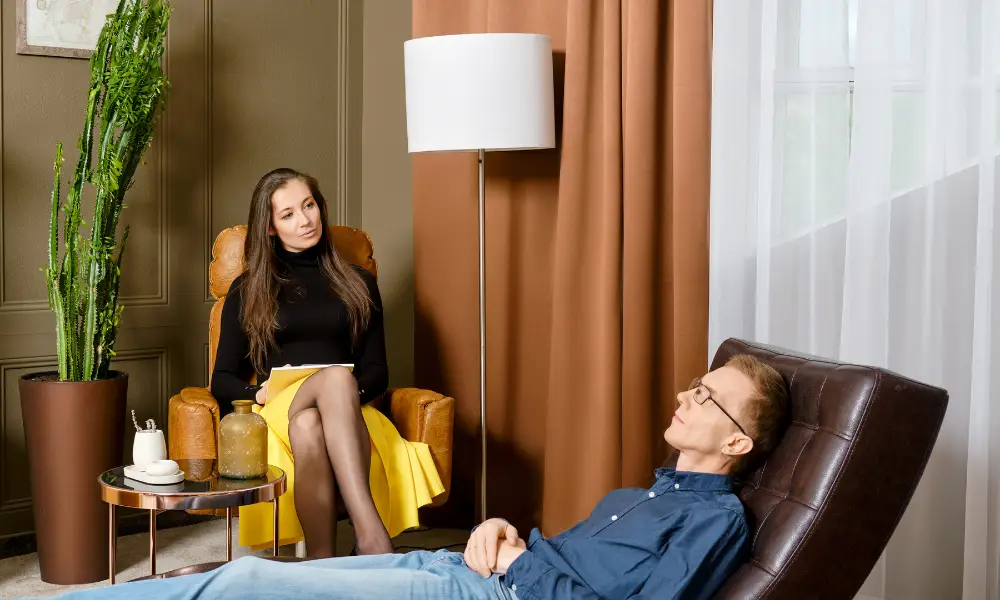Handling Generalized Anxiety Disorder (GAD) can be really tough. It’s like being stuck in a never-ending storm, with worries spinning around in your head and feeling uneasy all the time. But what if you could find a place where your anxiety doesn’t call the shots? That’s where Cognitive Behavioral Therapy (CBT) comes into play. It’s a strong method that has helped many people, turning their turmoil into peace. In this comprehensive guide, we’ll walk you through the essentials of CBT and how it stands as a beacon of hope for those grappling with GAD. So, let’s embark on this journey together, exploring how CBT can be your ally in conquering Generalized Anxiety Disorder and reclaiming control of your life.
Contents
Understanding Generalized Anxiety Disorder (GAD)
 If you’re feeling constantly worried, even about small things, you might be dealing with Generalized Anxiety Disorder (GAD). It’s a condition that affects a lot of people, making everyday life feel overwhelming and stressful. So, let’s break it down to understand it better.
If you’re feeling constantly worried, even about small things, you might be dealing with Generalized Anxiety Disorder (GAD). It’s a condition that affects a lot of people, making everyday life feel overwhelming and stressful. So, let’s break it down to understand it better.
- Generalized Anxiety Disorder is more than just feeling stressed out. It’s a chronic condition where you find yourself anxious most of the time, even when there might not be a clear reason for it. People with GAD often expect the worst, even when things are going well.
Recognizing the Symptoms
There are several signs that might indicate you have GAD. You could be feeling restless or wound-up most of the time, get tired easily, find it hard to concentrate, feel irritable, have muscle tension, or face sleep problems. It’s not just about feeling anxious; it affects your physical health, too.
The Impact on Your Life
Living with GAD can be tough. It can interfere with work, school, and relationships. You might find it hard to do daily activities, feeling like everything is much harder than it should be. It’s not just a matter of “snapping out of it”; it’s a condition that needs care and attention.
By understanding what GAD really is, its symptoms, causes, and how it can affect your life, you’re taking the first step toward managing it. And as we move forward, we’ll explore how Cognitive Behavioral Therapy (CBT) can be a powerful tool in helping you navigate through this.
How CBT Addresses GAD: The Core Principles

Cognitive Behavioral Therapy (CBT) stands out as a particularly effective treatment for Generalized Anxiety Disorder (GAD), thanks to its structured approach and evidence-based strategies. Let’s dive into how CBT directly targets and alleviates the symptoms of GAD through its core principles.
Changing Thought Patterns
A central part of CBT is helping individuals recognize and change negative thought patterns. People with GAD often have recurring anxious thoughts that can amplify their worries. CBT works by identifying these thoughts and teaching strategies to challenge and alter them, leading to a decrease in anxiety levels.
The Role of Behavioral Change
CBT also focuses on changing behaviors that contribute to anxiety. For instance, someone with GAD might avoid certain situations due to fear or worry. CBT helps in gradually exposing the person to these situations, allowing them to learn that the anticipated negative outcomes may not happen, and they can handle the situation better than they thought.
Developing Coping Skills
Through various exercises and techniques, CBT equips individuals with practical skills to manage their anxiety. This includes learning how to calm the mind and body, practicing mindfulness, and employing problem-solving skills in stressful situations.
Building Resilience
CBT is not just about managing current anxiety; it’s also about building resilience for the future. By changing thought patterns and behaviors, individuals can become more resilient in the face of stress, reducing the likelihood of future anxiety episodes.
The Importance of Homework and Practice
CBT is a collaborative effort between the therapist and the individual. Homework assignments, like journaling or practicing specific skills, are a crucial component of CBT, ensuring that the strategies learned during sessions are applied in real-life situations.
By addressing Generalized Anxiety Disorder from both a cognitive and behavioral standpoint, CBT provides a comprehensive approach to managing anxiety. It empowers individuals with the tools they need to break the cycle of anxiety, leading to lasting change and a greater sense of control over their lives.
CBT Techniques for Managing Anxiety
 Managing Generalized Anxiety Disorder (GAD) becomes more manageable when you have a set of effective techniques at your disposal. Cognitive Behavioral Therapy (CBT) offers a variety of strategies to help reduce and manage anxiety symptoms. Here’s a rundown of some of the most impactful techniques:
Managing Generalized Anxiety Disorder (GAD) becomes more manageable when you have a set of effective techniques at your disposal. Cognitive Behavioral Therapy (CBT) offers a variety of strategies to help reduce and manage anxiety symptoms. Here’s a rundown of some of the most impactful techniques:
- Cognitive Restructuring: This involves identifying and challenging harmful thought patterns. When you catch yourself thinking something negative, stop and ask: Is this thought based on facts or feelings? Is there a more positive way to look at this situation?
- Mindfulness and Relaxation Techniques: Practices like deep breathing, progressive muscle relaxation, and mindfulness meditation can help calm your mind and reduce physical symptoms of anxiety.
- Problem-Solving: Learn to approach anxiety-inducing situations with a problem-solving mindset. Break the issue down into manageable parts, identify possible solutions, and take steps to address the problem.
- Journaling: Keep a daily journal of your thoughts, feelings, and behaviors. This can help you identify patterns in your thinking and become more aware of how certain thoughts contribute to your anxiety.
- Graded Exposure: This is a step-by-step method where you gradually face and overcome your fears. Start with something that causes you a little anxiety, and once you’re comfortable with that, move on to the next level.
- Positive Activities: Schedule positive activities throughout your day or week. Engaging in activities that you enjoy and that make you feel good can significantly boost your mood and reduce anxiety.
- Thought Records: Keep a thought record where you write down anxious thoughts, identify cognitive distortions, and reframe these thoughts in a more positive light.
- Assertiveness Training: Learn to express your thoughts and feelings in a clear and respectful way. This can help reduce anxiety in social situations and improve your relationships.
Implementing these CBT techniques requires practice and patience. It might be challenging at first, but with time and consistent effort, you’ll find that they can significantly reduce your anxiety and improve your quality of life.
Common Challenges and How to Overcome Them
 Adopting Cognitive Behavioral Therapy (CBT) strategies for managing Generalized Anxiety Disorder (GAD) can be a transformative journey, but it’s not without its challenges. Let’s explore some common hurdles and strategies to overcome them, ensuring a smoother path to recovery.
Adopting Cognitive Behavioral Therapy (CBT) strategies for managing Generalized Anxiety Disorder (GAD) can be a transformative journey, but it’s not without its challenges. Let’s explore some common hurdles and strategies to overcome them, ensuring a smoother path to recovery.
- Challenge 1: Starting CBT can feel overwhelming, especially when you’re already dealing with anxiety.
Solution: Begin slowly. Focus on one technique at a time and give yourself the grace to progress at your own pace. - Challenge 2: CBT often involves confronting anxiety-provoking thoughts and situations, which can be uncomfortable.
Solution: Remind yourself that this discomfort is temporary and a necessary part of the healing process. The more you face these emotions, the less power they will hold over you. - Challenge 3: Recognizing and challenging negative thought patterns is a key component of CBT, but it can be difficult in the beginning.
Solution: Use a thought journal to record your thoughts throughout the day. Over time, you’ll become more aware of your cognitive patterns. - Challenge 4: Consistent practice is crucial for the success of CBT, but it can be hard to stay motivated.
Solution: Set realistic goals and establish a routine. Celebrate small victories along the way to stay motivated. - Challenge 5: Some individuals expect immediate results from CBT, leading to frustration when change doesn’t happen overnight.
Solution: Understand that progress in CBT is gradual. Celebrate small improvements and stay committed to the process. - Challenge 6: Sharing personal thoughts and feelings in therapy can evoke fear of being judged.
Solution: Remember that therapists are trained professionals who provide a safe, non-judgmental space for you to express yourself. - Challenge 7: Implementing CBT techniques in real-life situations can be challenging.
Solution: Practice the skills you learn in therapy in low-stakes environments first. Gradually build up to more challenging scenarios as you become more confident.
By acknowledging these challenges and implementing these solutions, you can navigate the road to recovery with resilience and determination. Remember, you’re not alone in this journey, and overcoming these hurdles is a crucial part of building a stronger, healthier you.
Tips for Finding a CBT Therapist Specialized in GAD
 Finding the right therapist is a crucial step in effectively managing Generalized Anxiety Disorder (GAD) through Cognitive Behavioral Therapy (CBT). Here’s a guide to help you navigate this process and make an informed decision.
Finding the right therapist is a crucial step in effectively managing Generalized Anxiety Disorder (GAD) through Cognitive Behavioral Therapy (CBT). Here’s a guide to help you navigate this process and make an informed decision.
- Start by doing your own research online. Look for therapists who specialize in CBT and have experience dealing with GAD.
- Ask for referrals from friends, family, or your primary care doctor.
- Ensure that the therapist is licensed and has relevant qualifications.
- Look for therapists with a strong background in CBT and specific experience in treating GAD.
- During your initial consultation, ask about their approach to treating GAD and the CBT techniques they utilize.
- Consider the therapist’s availability and whether it fits with your schedule.
- Ensure that their location is convenient for you, or inquire about the possibility of online sessions.
- Pay attention to how you feel during the initial consultation and trust your instincts.
- Clarify the cost of therapy sessions and check if they accept insurance.
- Inquire about any available payment plans or sliding scale fees if cost is a concern.
- If possible, look for testimonials from previous clients to get an idea of their experiences.
- Choose a therapist who encourages you to share your thoughts and feelings openly.
- If you don’t feel a connection with the first therapist you meet, it’s okay to try someone else.
- Finding the right fit is essential, and it’s worth taking the time to find a therapist who meets your needs.
- Online therapy platforms like TherapyMantra offer convenient access to qualified therapists specialized in CBT and GAD.
- Explore these options if you prefer the flexibility and comfort of remote sessions.
Finding a CBT therapist specialized in GAD might take some time, but it’s a worthwhile investment in your mental well-being. Use these tips to guide your search, and remember that the right therapist can make a significant difference in your journey to managing anxiety.
Conclusion
Dealing with Generalized Anxiety Disorder is a challenging journey, but it’s a path you don’t have to walk alone. CBT has proven to be an effective ally in this battle, providing strategies and support to transform your anxious thoughts into a state of calmness and control.
Remember, recognizing the need for help is a monumental first step, and finding the right therapist is the next crucial phase.
If the search for a therapist feels overwhelming, or if you’re looking for a flexible and accessible option, Online Anxiety Counseling at TherapyMantra is here to assist you. Book a trial Online therapy session today, and embrace the journey to effective anxiety management with the right support by your side. Your path to tranquility starts here, and we’re here to guide you every step of the way.


